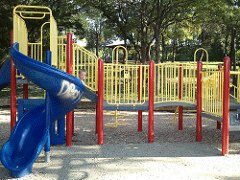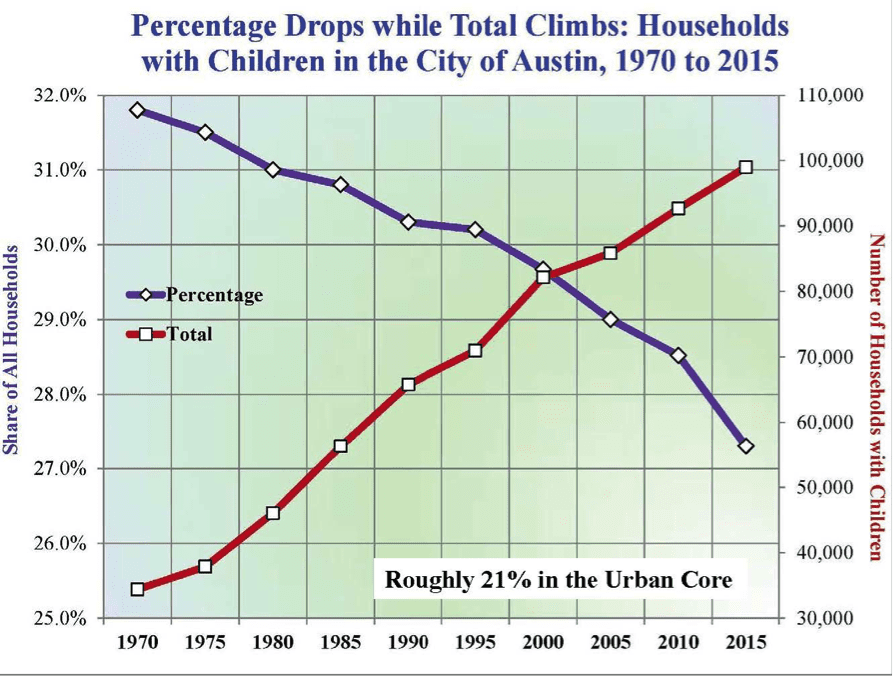
Lower birth rates, better public education options outside the city, and housing affordability are three main reasons why not only is Austin not attracting new families, it's losing the families it once had.
Austin’s City Demographer, Ryan Robinson, explains in his Top Ten Demographic Trends in Austin, Texas: “Citywide, the trends have been similar in that the overall number of families-with-children has increased while the share of total households of families-with-children has decreased.”
Impacts on Community
Housing
Demographic shifts in central Austin demonstrate not only low birth rate but, in central Austin, every cohort lost children within the urban core. This trend influences the housing product types that the local market is demanding, and supplying, in urban Austin. One example, an area that experienced a gain in children, is dominated by single-parent renters.
Schools & Services
Under-enrollment and school closures are a reality in Austin, Texas. The Austin Independent School District (ISD) is facing challenges outlined in a recent demographic study that project it will lose 6,140 students over the next 10 years. While the absolute number of children in Austin is increasing, their share of total population is declining. The City demographer notes, “School systems and health care providers will have a hard time managing the increasing absolute need in light of this loss in share.”
Contributing Factors
Poorer Children: Children in Austin are increasingly poorer, with 1 in 4 under 18 living below the poverty level.
Missing Middle: Census data shows that Austin continues to have pockets of affluent families with children, but the middle-class family is becoming virtually extinct in the urban core. Austin’s demographer warns that Austin has a “missing middle” problem typified by single-family, detached homes on large lots in urban neighborhoods. Austin has a lack of attached product, like row homes or town homes, as existing Austin zoning does not readily allow for this type of housing.
The Urban Land Institute Austin issued a special report, “The Missing Middle: Affordable Housing for Middle Income Families in the City of Austin,” that details the challenges of regulatory barriers in Austin to build “missing middle” housing. A shift from single-family, large lot zoning must make way for denser housing options that are available at a price point that is affordable to create real family housing options. Austin is also considering the use of accessory dwelling units and small lot mmnesty provisions to help solve this planning obstacle. Providing these types of housing will work to attract and retain the middle class back to the city.
Assumptions
Four assumptions must be considered for a successful overall plan to retain and attract families (back) to the urban core across the nation and (re)build Family Housing.
1) A market for “family housing” genuinely exists at denser levels;
2) Family housing can be produced at appropriate price points within the city;
3) Zoning and other regulations must allow “missing middle” housing types and denser residential development; and
4) In addition to addressing housing affordability concerns for families, cities must work to improve public schools; to ensure access to adequate, kid-friendly open space and age-appropriate community amenities; and to create access to a wide range of services including affordable and convenient child care options for urban core families.
Supply & Demand
Market forces generally prevail and provide housing that's in demand. For the foreseeable future, this demand will be driven by baby boomers, empty nesters and Millennials. Family Housing is not a great share of demand, given demographic trends; and in many cities, the key assumptions fail at some level.
Facing similar challenges, the Seattle Planning Commission issued “Family-Sized Housing: An Essential Ingredient to Attract and Retain Families with Children” in January 2014, to encourage family-friendly development. Seattle’s call to action is applicable to all cities struggling with retaining and attracting families with children–“a multipronged action plan now to increase the supply and availability of family-sized housing for families with children at a wide spectrum of income levels.”
Making sure cities have the availability of housing product types at prices households can afford is the goal. In some cases, cities like Austin are looking at ways to incentivize the development of family housing in the urban core–to make sure the kids are all right, and truly welcome, in the city.
(Photo credit: Longview Park playground in Austin, Texas, by Lars Plougmann via flickr, CC BY-SA 2.0)






This article is important for saying out loud there are problems with the LIHTC financing model. It has driven up the cost so much that of course each unit uses up more of the limited money available than makes business sense. A traditional lender would never finance the total cost of these projects.
The Supreme Court decision about disparate impact adds to the housing agencies’ problems in locating housing projects. After 15 years in this business I have only seen cities join NIMBY groups in discouraging affordable housing instead of working with the agencies to create opportunities in zip codes with lower poverty concentrations.
Cities will have to start backing the projects in better areas if they want to attract and retain working income families. Since the middle class is shrinking everywhere this is the income group for whom we should be building housing.
^^Couldn’t agree more with that post. Well put Maryellen